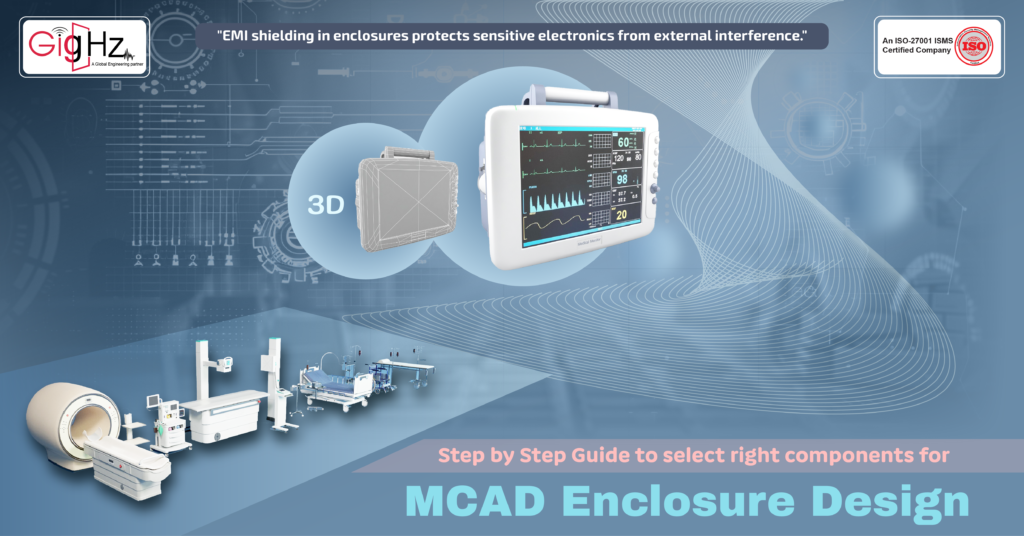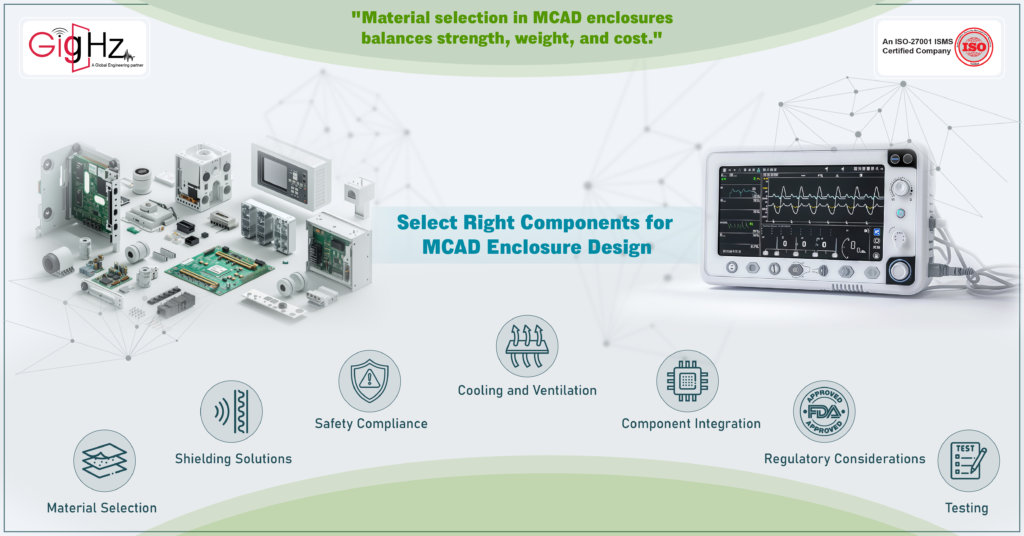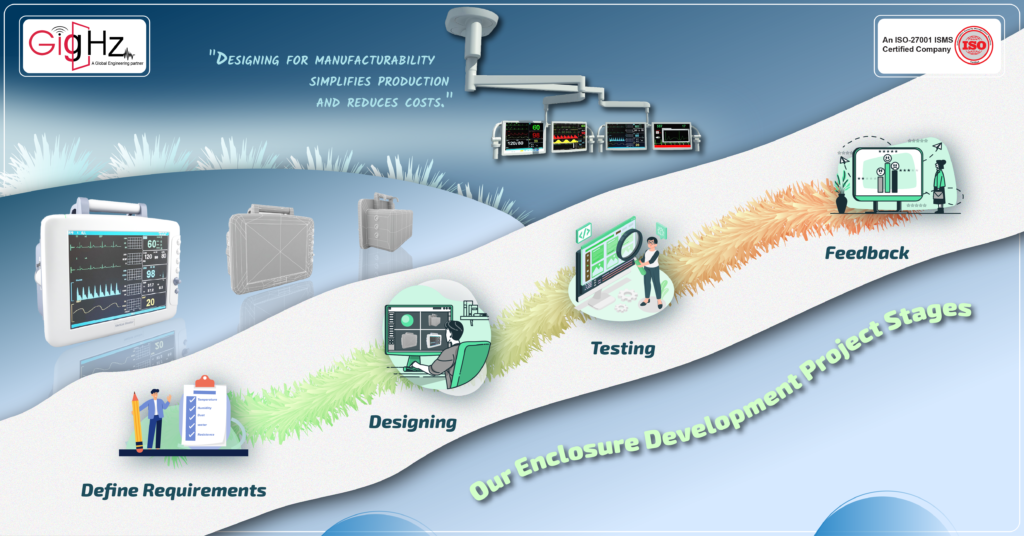7 Step by Step Guide to select right components for MCAD Enclosure Design
- Posted On:
- August 14, 2024
- Category:
- Mcad

MCAD Enclosure Design
Hey there!
Smileful day to all!
Being aware of new innovations is highly beneficial for enhancing our experience and expanding our knowledge, don’t you think?
During a web search in the medical industry, a report on eyesight, highlighted challenges faced by the medical field, in designing MCAD enclosures.
The report posed a question:
“What is the process for choosing the correct components for MCAD Enclosure Design?” as a solution to these challenges.
When you are designing a custom enclosure for your specific project or prototype, it’s important to start on the right foot by choosing the component that will best suit your needs.
To recap, there a few good questions to guide you in your choice:
- Where will my enclosure be stored?
- Will my case need to withstand harsh environmental elements?
- How much is weight an issue for my enclosure?
- How budget-conscious do I need to be?
Once you have answered these questions and considered your needs thoroughly, you will have some guidance on selecting the right metal for your custom enclosure or part.
Let we dive deeper for more!
Step by Step Guide to select right components for mcad Enclosure Design

In the medical field, MCAD enclosure designers are encountering challenges related to the development of enclosures for cutting-edge medical devices and equipment.
With the rapid advancements in healthcare technology, there is a growing need for enclosures that can house intricate electronic components while meeting stringent regulatory requirements and ensuring patient safety.
Designing enclosures for Patient Monitors in the medical field presents unique challenges due to the stringent requirements for electromagnetic compatibility, safety, and patient comfort.
Selecting the right components for Patient Monitors enclosures demands careful consideration of specialized materials, shielding solutions, and regulatory compliance.
Here’s how you can navigate the complexities of component selection for Patient Monitors enclosures:
1. Material Selection:
Non-Magnetic Materials: Choose non-magnetic materials such as aluminum, titanium, or specific grades of stainless steel to prevent interference with the Patient Monitors.
Radiofrequency (RF) Transparency: Opt for materials that are RF-transparent to ensure minimal signal attenuation during imaging procedures.
2. Shielding Solutions:
RF Shielding: Implement high-performance RF shielding materials like copper to contain electromagnetic emissions and prevent external interference.
Gradient Shielding: Incorporate gradient shielding components to reduce eddy currents and distortions in the magnetic field within the enclosure.
3. Safety Compliance:
Biocompatible Materials: Use biocompatible materials for components that come into contact with patients to ensure safety and minimize allergic reactions.
4. Cooling and Ventilation:
Heat Dissipation: Integrate efficient cooling systems, such as liquid cooling solutions or specialized fans, to manage heat generated by the Patient Monitors components.
Airflow Management: Design ventilation systems that maintain positive pressure inside the enclosure to prevent the entry of external contaminants while ensuring proper airflow for cooling.
5. Electrical Component Integration:
EMI Filtering: Include electromagnetic interference (EMI) filters for sensitive electronic components to prevent disruptions from the Patient Monitors’s strong magnetic fields.
Isolation Barriers: Implement isolation barriers for electrical connections to mitigate potential electromagnetic interference and ensure signal integrity.
6. Regulatory Considerations:
FDA Compliance: Ensure that all enclosure components meet the regulatory requirements set forth by the Food and Drug Administration (FDA) for medical device safety and performance.
CE Marking: Comply with CE marking standards for electromagnetic compatibility (EMC) to guarantee that the enclosure components do not interfere with the Patient Monitors functionality or accuracy.
7.Customization and Testing:
Custom Enclosure Design: Work closely with specialized enclosure manufacturers to develop custom solutions tailored to the specific requirements of the Patient Monitors and its operational environment.
Thorough Testing: Conduct rigorous testing of the selected components and the assembled enclosure to validate performance, safety, and compliance with industry standards before deployment.
By extrapolating and adapting the technical considerations for Patient Monitors enclosures to other MCAD enclosure designs in the medical field, designers can enhance the functionality, safety, and regulatory compliance of a broad range of medical devices.
Customization based on the specific needs of each application is key to ensuring the success of MCAD enclosure designs across different medical specialties.
Our Enclosure Development Project Stages

Within our company, we guide future devices and we assist you to design and develop, ensuring a comprehensive and seamless journey from conception to realization.
Define Requirements
We start by defining the enclosure’s purpose and then evaluate environmental requirements (temperature, humidity, dust, and water resistance).
Determining the necessary size and shape follows, considering the components.
We gather technical information about these components and account for relevant legal and compliance standards in the design process.
Designing
We create initial designs for the enclosure, integrating the provided information. Factors such as manufacturability, aesthetics, and ease of assembly are carefully considered.
We conduct a comprehensive analysis of the pros and cons related to various enclosure materials.
Using computer-aided design (CAD) tools, we develop accurate 3D modeling of the enclosure, keeping in mind the precise alignment of dimensions and tolerances with the specified requirements.
Testing
Following the design phase, our in-house engineers swiftly commence real-world scenario testing of your model using software like FEA (Finite Element Analysis) and CFD (Computational Fluid Dynamics).
This rigorous testing is aimed at validating the concept under real-world conditions.
If the results are unsatisfactory or reveal any issues, corrective action is taken. Necessary adjustments are implemented to ensure that the final design seamlessly aligns with your requirements.
Potential Feedback and Improvements
After the successful testing phase, our team of experts analyze your valuable feedback and incorporate it into the final design.
Our goal is not just to meet but to surpass your expectations.
We refine the design through iterative iterations and optimization to enhance its overall quality.
The final product is then delivered to you in the file format of your preference, ensuring convenient accessibility at your convenience.
Final Thoughts
Selecting the right components for MCAD enclosure design is a crucial process that involves thorough research, consideration of technical specifications, compatibility, durability, and functionality.
By following a step-by-step guide, you can ensure the successful creation of an effective and reliable enclosure that meets the requirements of the electronic device while addressing any challenges that may arise during the design process.
Stay updated on our services—connect with our founder on LinkedIn: https://www.linkedin.com/in/chandra-thimma/recent-activity/all/
Table of Contents
Latest Post
Get Customized Engineering CAD Design Service

Book a Free Consultation Call
Partner with Gighz and bring your most innovative design concepts to life. Our engineering cad services accelerate development so you can focus on your big vision.


